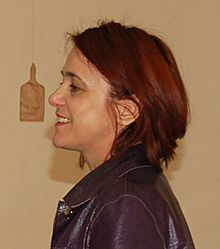Marianne Csaky facts for kids
Quick facts for kids
Marianne Csaky
|
|
|---|---|

Marianne Csaky
|
|
| Born |
Budapest, Hungary
|
| Nationality | Hungarian |
| Known for | sculptures, photography, installation art, painting |
Marianne Csaky (born 1959, Budapest, Hungary) is a Hungarian writer and sculptor. She studied art, ethnography (the study of cultures), and philosophy. Marianne started showing her art in Budapest in 1989. From the beginning, she has been known for her unique and thought-provoking art. She also writes poems, essays, and translates texts.
Contents
About Marianne Csaky
Marianne Csaky was born in Hungary. Today, she lives and works in Budapest and Brussels. She has also spent time living and creating art in other places. These include Seoul, Korea, the United States, France, and Germany. She often worked there as an artist-in-residence.
Marianne Csaky's Artworks
Marianne Csaky creates art using many different materials. She works with photos, paintings, sculptures, and even embroidery. She also makes videos and installation art. When she was younger, she mostly used leather for her sculptures and 3D art pieces.
Early Sculptures
In her early art, Marianne made sculptures from pieces of waste wood and plaster. She was interested in how we use language and how we think. She also explored the idea that our minds have both male and female qualities. Famous works from this time include Aphrodite Urania (1995) and Feast (1990). During this period, she was inspired by ancient Greek philosophers, especially Plato's book Symposium.
Slanting Space Installation
Csaky also built large art pieces that changed how a space felt. These works showed how our ideas and beliefs can shift and change. For example, in 1997, she built a new slanting floor in Gallery 56. This made visitors feel a bit off-balance. It was her way of making people think about how we understand the world.
Exploring Personal History
Around the year 2000, Marianne became interested in personal and family history. She created art series like My Skins (2005) and Time Leap (2007-2008). These works explored her family's past and how memories work.
My Skins Series
In the My Skins series, Marianne used pig leather again. She made leather curtains and wall hangings with drawings and raised patterns. This choice of material connected to her childhood memories. After the 1956 revolution in Hungary, her grandfather had to live on a farm. There, he also produced animal hides. The drawings on the leather are based on old family photos from Marianne's childhood.
Time Leap Series
The Time Leap series (Light Boxes, 2007-2008, Stitched Photos, 2008) combines different layers of time. It shows Marianne's efforts to change old records and memories. By doing this, she tries to rewrite the past and even change the present.
Light Boxes
For Light Boxes, Marianne took new color photos of herself. Then, she put her adult self into old black-and-white photos of herself as a child. So, in each picture, she appears twice, at two different ages. She built a special setup for these film negatives. It had a wire frame and a mirror behind each negative. The mirror reflected light from a bulb, making the negative images visible.
Stitched Photos
The Madonna (2008) and Queen (2008) pieces are part of the Time Leap – Stitched Photos series. These also use old family negatives. The photos show staged scenes, like people dressing up. Marianne is interested in how family photos show what people want things to be, even if it's not real. She believes that even if these images of desires seem fake, the feelings behind them are very real.

